
A song is a musical composition performed by the human voice. This is often done at distinct and fixed pitches (melodies) using patterns of sound and silence. Songs contain various forms, such as those including the repetition and variation of sections.
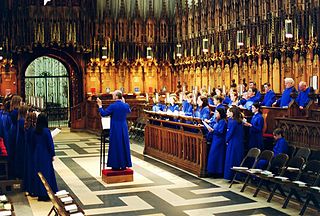
A choir is a musical ensemble of singers. Choral music, in turn, is the music written specifically for such an ensemble to perform. Choirs may perform music from the classical music repertoire, which spans from the medieval era to the present, or popular music repertoire. Most choirs are led by a conductor, who leads the performances with arm, hand, and facial gestures.
Music of Serbia represents the musical heritage of Serbia, both historical and modern. It has a variety of traditional music styles, which are part of the wider Balkan musical tradition, with its own distinctive sound and characteristics.

Stevan Stojanović, known as Stevan Mokranjac was a Serbian composer and music educator. Born in Negotin in 1856, Mokranjac studied music in Belgrade, Munich, Rome and Leipzig while in his twenties. Later, he became the conductor of the Belgrade Choir Society and founder of the Serbian School of Music and the first Serbian string quartet, in which he played the cello. He left Belgrade at the beginning of World War I and moved to Skopje, where he died on 28 September 1914.
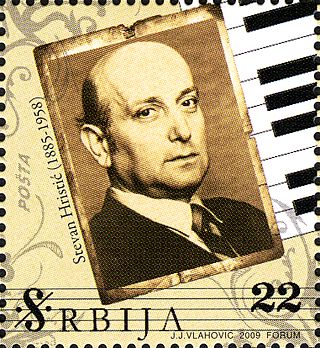
Stevan Hristić was Serbian composer, conductor, pedagogue, and music writer. A prominent representative of the late romanticist style in Serbian music of the first half of the 20th century.
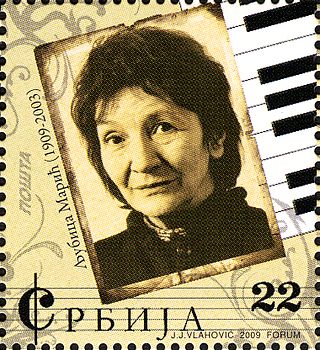
Ljubica Marić was a composer from Yugoslavia. She was a pupil of Josip Štolcer-Slavenski. She was known for being inspired by Byzantine Orthodox church music. She was professor at the Faculty of Music in Belgrade and a member of the Serbian Academy of Sciences and Arts. Ljubica Marić is considered to be the most original Serbian composer of the twentieth century and musically the most influential one.
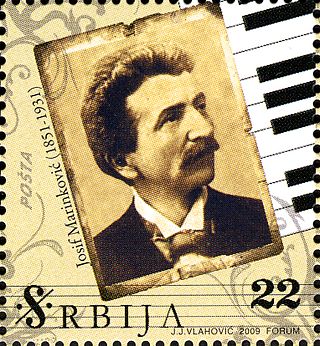
Josif Marinković was a Serbian composer and choral director. Like his younger contemporary Stevan St. Mokranjac, he was devoted to mainly vocal genres—lied and choral. Marinković was a romanticist with a pronounced affinity for melodic expression. He invested exceptional attention to the text declamation, which represented a rather novel quality in Serbian music at the time.
Jewish music is the music and melodies of the Jewish people. There exist both traditions of religious music, as sung at the synagogue and domestic prayers, and of secular music, such as klezmer. While some elements of Jewish music may originate in biblical times, differences of rhythm and sound can be found among later Jewish communities that have been musically influenced by location. In the nineteenth century, religious reform led to composition of ecclesiastic music in the styles of classical music. At the same period, academics began to treat the topic in the light of ethnomusicology. Edward Seroussi has written, "What is known as 'Jewish music' today is thus the result of complex historical processes". A number of modern Jewish composers have been aware of and influenced by the different traditions of Jewish music.
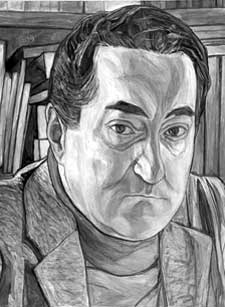
Aleksandar Obradović was a Serbian 20th-century composer and professor at the Faculty of Music in Belgrade. He was a Rector of the University of Arts in Belgrade (1979–1983).
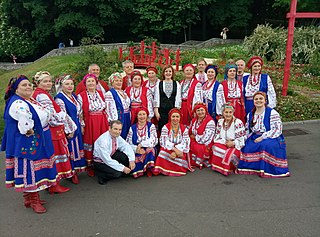
Ukrainian folk music includes a number of varieties of traditional, folkloric, folk-inspired popular music, and folk-inspired European classical music traditions.
Renaissance Ensemble Serbia is the first early music ensemble in Serbia and the second in south-eastern Europe, having been founded in 1968. Ensemble Renaissance usually focuses on the music of the Middle ages, Renaissance and Baroque. Occasionally, however, Ensemble performs modern music on ancient instruments.
Isidora Žebeljan was a Serbian composer and conductor. She was a professor of composition at the Belgrade Music Academy and a Fellow of the Serbian Academy of Sciences and Arts.

Enriko Josif was a Serbian composer, pedagogue and musical writer, and member of the Serbian Academy of Sciences and Arts.
Svetozar Saša Kovačević was a Serbian composer, music pedagogue and church organist. He was one of Serbia's best-known contemporary composers.
Rajko Maksimović is a composer, writer, and music pedagogue. One of the most significant Serbian composers of our time, Maksimović has been and remains active in creating works for different ensembles.

Music of the Old Serbia is a debut vinyl album by Ensemble Renaissance, released in 1983 on the PGP RTB label. It is also Ensemble's first album with early music of Serbia. They will revisit the theme of Serbian Medieval songs and dances on the Roots of the Balkan, and some of the material from this album will be remastered on the Music of Old Serbia - Chants from 14th to the 18th century dedicated exclusively to the Medieval Serbian chant. The A side of the record deals with the earliest attested Serbian composers belonging to the Serbo-Byzantine musical style while the B side contains secular and ritual songs and dances. Most of the material was taken from the books by the Serbian ethnomusicologists Dimitrije Stefanović, Živojin Stanković, Kosta Manojlović, Đorđe Karaklajić (unpublished), and others.

Early Serbian Music is a Cassette and Videocassette album by Ensemble Renaissance, released in 1989 on the PGP RTB label. It is their third album with early music of Serbia and their 7th album overall. Similar to the concept of their first album on the A side of the record are secular songs and dances from the Eastern Serbia and Kosovo. The B side of the cassette deals with Serbian chant in the period of Ottoman rule and Great Serbian Migrations.
Steven Sametz is active as both conductor and composer. He has been hailed as "one of the most respected choral composers in America." Since 1979, he has been on the faculty of Lehigh University in Bethlehem, Pennsylvania, where he holds the Ronald J. Ulrich Chair in Music and is Director of Choral Activities and is founding director of the Lehigh University Choral Union. Since 1998, he has served as Artistic Director of the professional a cappella ensemble, The Princeton Singers. He is also the founding director of the Lehigh University Summer Choral Composers’ Forum. In 2012, he was named Chair of the American Choral Directors Association Composition Advisory Committee.
Zoran Hristić was a Serbian composer. He had a freelance artist status for a long time. At the initiative of Dušan Radović in 1979, he was nominated an editor, director and founder of the Concert Studio B. from 1982 to 1989, he was the chief music editor of Radio Belgrade, and then moved on RTVB, later RTS where he was editor in chief of the editorial board of Music programme until 1995.

Mehmet Ali Sanlıkol is a Grammy nominated Turkish-American composer and CMES Harvard University fellow (2013-15) who is a jazz pianist and singer that also performs a number of Near and Middle Eastern instruments as well as the keyboardless synthesizer Continuum Fingerboard and the SANLIKOL Renaissance 17, a digital microtonal keyboard designed and conceived by himself.












